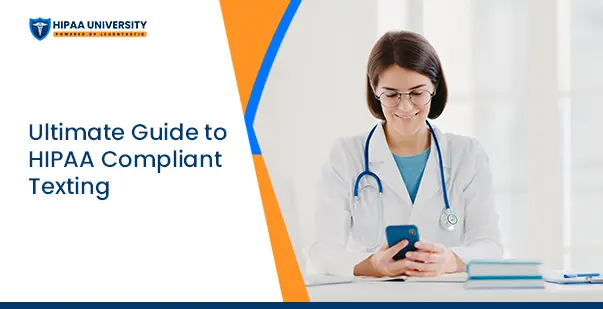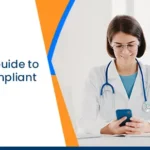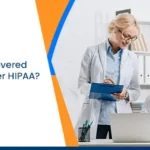Ultimate Guide to HIPAA Compliant Texting

October 5, 2024
Table Of Content(s)
- Introduction
- Understanding HIPAA: Key Principles and Requirements
- The Importance Of Texting in Healthcare
- The Risks of Non-Compliant Texting
- What are the tips to ensure secure messaging?
- Training Staff on HIPAA Compliance
- What are the legal considerations for HIPAA Text Messaging?
- The Future Of Texting in Healthcare
- Conclusion
In healthcare, communication is the key. In the last few decades, texting has become an important tool for both patients and providers. But are you sure if information transferred via texting is protected or not? Or, how much do you know about HIPAA compliant texting?
80% of healthcare professionals use texting for patient interactions. A single breach of data can result in reputational damage and might cost you hefty fines.
In this blog, we will learn about the best practices, common pitfalls and important tools to protect data over texting. So are you ready to unlock the secrets of safe texting? Without delay, let’s begin.
Understanding HIPAA: Key Principles and Requirements
The Health Insurance Portability and Accountability Act (HIPAA) protects patient information in the healthcare industry.
Understanding the requirements of HIPAA helps healthcare professionals maintain compliance.
Below are the core principles and requirements of HIPAA:
- Privacy Rule: Establishes standards for protecting individuals’ medical records and personal health information (PHI).
- Security Rule: Sets guidelines for ensuring the confidentiality, integrity, and availability of electronic protected health information (ePHI).
- Transactions and Code Sets Rule: Regulates the standardization of electronic healthcare transactions to improve efficiency and accuracy.
- Unique Identifiers Rule: Requires healthcare providers, health plans, and employers to use unique identifiers for identification in electronic transactions.
- Enforcement Rule: Outlines the procedures for investigations, penalties, and compliance reviews of HIPAA violations.
- Business Associate Agreements (BAAs): Mandates that covered entities must enter into contracts with third parties who handle PHI. This ensures proper compliance with HIPAA standards.
Read More: Best HIPAA Compliance Software in 2024
The Importance Of Texting in Healthcare
The convenience and immediacy of texting help the overall patient experience. It also streamlines care delivery. Here’s why texting is vital in the healthcare landscape:
- Improved Patient Engagement: Texting helps real-time communication, encouraging patients to stay connected and actively participate in their care.
- Faster Response Times: Quick messaging allows for immediate responses to patient inquiries, reducing wait times and enhancing satisfaction.
- Appointment Reminders: Text reminders help decrease no-show rates, ensuring that patients attend their appointments and receive necessary care.
- Efficient Care Coordination: Healthcare teams can easily communicate updates and collaborate on patient care, improving outcomes.
- Accessibility: Texting allows patients to communicate from the comfort of their homes, making healthcare more accessible, especially for those with mobility issues.
- Cost-Effective Communication: Texting reduces the need for phone calls and in-person visits, saving time and resources for both patients and providers.
- Secure Communication: When done in compliance with HIPAA, texting can securely transmit important health information while maintaining patient privacy.
Read More: When Does the State Privacy Law Supersede HIPAA?
The Risks of Non-Compliant Texting
Failing to abide by HIPAA regulations when texting can expose healthcare organizations to significant risks. Here are some key concerns:
- Legal Penalties: Violations can result in hefty fines, ranging from thousands to millions of dollars depending on the severity.
- Data Breaches: Non-compliant texting increases the risk of unauthorized access to patient information. This leads to potential data breaches.
- Loss of Patient Trust: Breaching patient confidentiality can damage relationships and trust between providers and patients.
- Reputation Damage: Organizations that fail to protect patient information may face negative publicity and long-term reputational harm.
- Operational Disruption: Compliance investigations can divert resources and disrupt normal operations, impacting overall patient care.
- Increased Liability: Non-compliance can lead to lawsuits from affected patients, further complicating legal and financial situations.
What are the tips to ensure secure messaging?
Ensuring secure messaging in healthcare is essential for protecting patient information. By following these tips, you can safeguard communications via texting effectively:
- Use HIPAA-Compliant Platforms: Select secure messaging apps specifically designed for healthcare that encrypt data both in transit and at rest.
- Implement Access Controls: Limit access to messaging platforms to authorized personnel only, and use strong passwords and two-factor authentication.
- Educate Staff on Compliance: Provide regular training to employees on secure messaging practices and HIPAA regulations to foster a culture of compliance.
- Obtain Patient Consent: Always seek patient consent before sending texts that contain PHI, ensuring they understand how their information will be used.
- Avoid Sensitive Information: Refrain from discussing sensitive medical details or test results via text. Use secure portals for such communications.
- Monitor Messaging Activity: Regularly audit and monitor messaging activity to detect any unauthorized access or suspicious behavior.
- Establish Clear Policies: Create and enforce policies regarding the use of texting for patient communication. Outline what is acceptable and what is not.
Training Staff on HIPAA Compliance
HIPAA training ensures that employees understand their responsibilities. This minimizes the risk of violations, and builds a culture of privacy. Here are key components to consider when implementing training programs:
- Comprehensive Overview of HIPAA: Provide an understanding of HIPAA regulations, including the Privacy Rule, Security Rule, and the implications of non-compliance.
- Role-Specific Training: Tailor training sessions to address the specific responsibilities and challenges of different roles within the organization.
- Real-Life Scenarios: Use case studies and scenarios to illustrate potential compliance issues and discuss best practices for handling sensitive information.
- Security Protocols: Educate staff on secure handling of patient data, including encryption, access controls, and the importance of strong passwords.
- Reporting Procedures: Clearly outline procedures for reporting suspected breaches or compliance violations to ensure timely action.
- Regular Refreshers: Conduct ongoing training sessions to keep staff updated on changes to HIPAA regulations and emerging security threats.
- Assessment and Feedback: Implement assessments to gauge understanding and gather feedback to improve future training sessions.
What are the legal considerations for HIPAA Text Messaging?
Healthcare texting involves various legal considerations to ensure compliance with regulations and protect patient information. Here are key points to keep in mind:
- HIPAA Compliance: Ensure that all text communications adhere to HIPAA regulations, safeguarding patient privacy and securing PHI.
- Patient Consent: Obtain explicit consent from patients before sending text messages that include health information, ensuring they are aware of how their data will be used.
- Documentation: Maintain records of text communications, especially those involving patient care, to support continuity and compliance.
- Retention Policies: Develop clear policies for the retention and disposal of text messages to align with legal and regulatory requirements.
- State Regulations: Be aware of state-specific lawsthat may impose additional requirements or restrictions on texting in healthcare settings.
The Future Of Texting in Healthcare
As technology continues to evolve, texting continues to play an even more significant role in healthcare communication. Here are some trends and developments to watch for:
- Increased Use of AI and Automation: AI-driven chatbots may assist in patient diagnosis, appointment scheduling, and answering common questions, streamlining communication.
- Enhanced Security Features: Future texting platforms will likely integrate advanced encryption methods and multi-factor authentication to further protect patient data.
- Integration with Telehealth Services: Texting will increasingly complement telehealth solutions. This will enable seamless communication between patients and providers during virtual visits.
- Personalized Patient Engagement: Tailored messaging strategies will improve patient engagement and adherence by sending customized reminders and health tips.
- Interoperability with EHR Systems: Improved integration with electronic health records will allow for more efficient sharing of information and streamlined workflows.
- Regulatory Adaptations: As texting becomes more prevalent, regulatory bodies may update guidelinesto address emerging challenges and best practices.
Conclusion
Understanding is important for anyone wanting to communicate via texting without breaching laws. The integration of texting into healthcare has improved patient engagement and operational efficiency.
As technology continues to evolve, staying informed about legal considerations will become most important. These emerging trends will ensure that providers can adapt and thrive in an increasingly digital landscape. So pave the way for a more connected and efficient healthcare system, enroll in a HIPAA course today!





